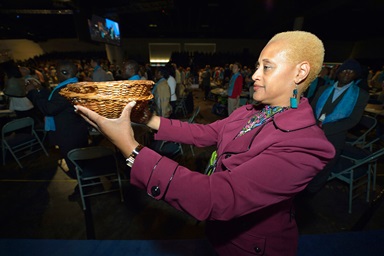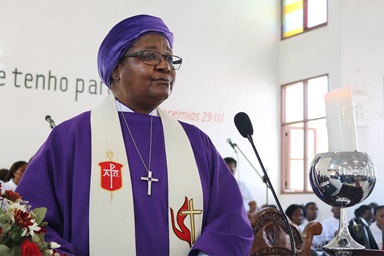The daily struggles of those living in Afghanistan’s remote rural areas are the stories that rarely make the news.
Yet these communities are where United Methodists have offered support through decades of war and political turmoil, says David Wildman, an executive with the denomination’s Board of Global Ministries who travels frequently to Afghanistan.
“For 49 years, we have partnered with Afghans and others to work on community health needs in various places around the country, in the best and worst of times,” he noted.
During a two-week trip to Afghanistan in late April and early May, Wildman visited a few of the projects that receive United Methodist support through The Advance, a denominational voluntary-giving program, and through grants from Global Ministries and the United Methodist Committee on Relief.
The long-time commitment to Afghanistan also has meant sacrifice. Nearly five years ago, Dan Terry, a United Methodist aid worker supported by the Board of Global Ministries, was among 10 aid workers killed Aug. 5, 2010, in a remote northeast section of the country by armed opposition fighters.
In the November-December 2013 issue of New World Outlook, Wildman wrote about the nearly 40 years that Terry and his wife, Seija, lived and worked in Afghanistan “out of a deep love—for God and for their Afghan neighbors. Whether we recognize it or not, Dan often stated, ‘We are all knotted together in the same carpet.’”
Helping rural communities
On his trip this spring, Wildman visited projects in Lal, where the Terrys lived in the 1970s and later in the 1990s to early 2000s. The couple worked as volunteers with local communities in healthcare and community development.
Situated in the central highlands of the Hazarajat, the Lal wa Sarjangal district is over a day’s drive to Kabul, which means access to resources can be difficult, Wildman pointed out.
As in most rural areas, there is little electricity – except for the occasional generator – with most heating and cooking fueled by dried animal dung, generating soot and provoking respiratory-related illnesses.
Water, sanitation and hygiene is a community development priority. One village project involved running a pipe down from a spring higher up in the valley to allow easier access to water in the winter, he said.
Although farming is still done by wooden plow, there are some innovations. Wildman visited experimental fields of wheat, where 10 to 15 varieties had been planted to see which would do best for high-elevation agriculture. “It was done in a cooperative fashion, so the whole village would benefit, not just one farmer,” he explained. A new greenhouse will extend the growing season and provide more vegetables.
Other programs focus on adult literacy and maternal health education. In 2014, 3,988 people participated in, or benefited directly from community development activities in Lal, with over 3,000 people benefiting indirectly.
Improving mental health care
In the western region of Afghanistan, United Methodists support a community mental health project and the Mental Health Training Center Herat.
Programs include residency training for mental health professionals and mental health awareness training for police, teachers, mullahs and other community workers to help distinguish behaviors caused by disorders such as epilepsy, depression and post-traumatic stress.
“After 35 years of war, probably three-quarters of the country has some type of traumatic stress impact,” Wildman noted. “What’s exciting is they’ve seen, after 15 years of work, this (awareness training) is really making a difference.”
For more than a decade, UMCOR also directly provided relief and development assistance in Afghanistan — helping rehabilitate war-zone territories, rebuilding homes and communities and boosting the recovery of agriculture —until passing on material assets to Afghan communities and organizations after closing its office there in 2014.
One of the poorest countries in the world, Afghanistan continues to face challenges. The past year, Wildman noted, has been the most violent since 2001. Afghan soldiers, civilians and aid workers have been killed, creating a difficult situation for both humanitarian work and community life.
Afghanistan’s population is very young, he said, and its government remains heavily dependent on aid. “With the drawdown of international military forces, contractors and some non-governmental organizations, there’s been a real contraction in the economy. It means there are now a lot of folks out of work and really struggling to make ends meet,” he added.
Kabul has grown dramatically since Wildman first traveled there in 2004, but after this recent visit, he describes Afghanistan’s capital as “a tale of several cities.” A building boom funded by the large international presence and by Afghan citizens who have returned after leaving in the 1980s and ‘90s has made some prosperous, but the growing population also includes many returning refugees looking for jobs.
“The needs (in Afghanistan) are still tremendous,” Wildman said, adding that, despite the security risks, “our commitment is to serve, no matter what.”
Bloom is a United Methodist News Service multimedia reporter based in New York. Follow her at https://twitter.com/umcscribe or contact her at (646) 369-3759 or [email protected]
Like what you're reading? Support the ministry of UM News! Your support ensures the latest denominational news, dynamic stories and informative articles will continue to connect our global community. Make a tax-deductible donation at ResourceUMC.org/GiveUMCom.






